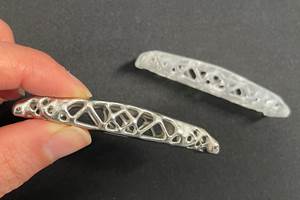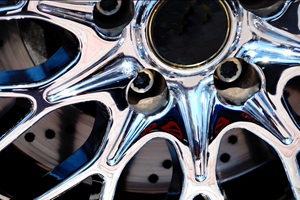Measuring Hardness and Wear in Electroless Nickel Coatings
Rich O’Brien from Bales Metal Surface Solutions says advances in coatings science have led to the development of multiple choices for surface finishes beyond hard chrome and electroless nickel.
Q: What is the best way to measure hardness and wear resistance in electroless nickel coatings?
A: Consulting with a knowledgeable supplier is your best bet for selecting the right surface treatment for a specific application. Intricate molds, corrosive materials, resins and advances in coatings science have led to the development of multiple choices for mold surface finishes beyond hard chrome and electroless nickel. It’s always wise to have a basic understanding of the pros and cons of various coatings. For example, in terms of wear resistance, an electroless nickel coating with nanosize diamond particles can be a better alternative to more “classic” options. How do you measure its abrasion resistance?
Measuring Hardness and Wear
The most common indicator of hardness is the Rockwell hardness test, as defined in ASTM E-18 (standard test method for Rockwell hardness of metallic materials). This method involves applying force to an indenter, then measuring the depth that the indenter reaches when it impacts the material. However, resistance to indentation is not the most appropriate measure of abrasion resistance. That title of distinction belongs to the Taber Wear Index, which shows the amount of material removed by a Taber Abraser (an instrument for accelerated wear testing) during an operation. This is a standard test a plater may conduct in-house as part of a company’s quality control and product development process.
The Taber test calculates the loss in weight of the material over a specified number of abrasion cycles — either the loss in weight per cycle or the loss in weight over the number of cycles required to remove a unit amount of coating thickness.
The chart below shows the results of a Taber test conducted in accordance with ASTM D4060 (standard test method for abrasion resistance of organic coatings by the Taber Abraser), which provides three types of calculations for wear resistance:
- Wear Index: Weight loss per specified number of revolutions (usually 1,000) under a specified load (500 or 1,000 grams).
- Wear cycles per mil: Number of cycles required to wear through a 0.001-inch thickness of coating.
- Cycles to failure: Number of test cycles to wear away the coating or to expose the substrate.
For this particular test, the wear index was used to compare five coatings: electroless nickel, electroless nickel-phosphorus matrix containing boron nitride particles, a co-deposit of electroless nickel and polytetrafluoroethylene (PTFE), hard chrome and an electroless nickel coating with nanosize diamond particles.
Step 1: As required by ASTM testing standards, a 1,000-gram weight was placed on an abrasive wheel that rotated at a constant speed. Test panels measuring 4 by 4 inches and made from S-16 cold-rolled, 20-gauge-thick steel were prepped and plated with each of the coatings. A minimum of 0.0010 inch of plating was applied.
Step 2: The beginning thickness and weight of each panel was recorded before the start of testing. Then, panels were stopped at every 1,000 cycles for more data collection. The process was repeated 10 times over a total of 10,000 cycles. Along the way, ASTM cleaning requirements were followed to ensure the data was accurate.
Step 3: The weight after abrasion testing was subtracted from the weight of the test panel before abrasion testing began. That number was then multiplied by 1,000 and divided by the number of cycles that were performed (also 1,000). The result is the specified wear rating for that finish. A higher number means the coating is less resistant to wear (more plating was removed) and a lower number indicates that the coating can better withstand wear (less plating was removed).
The results of this test case indicated that hard chrome had the best wear rating overall, but the electroless nickel coating with nanosize diamond particles far outperformed the other nickel products tested and was very close to hard chrome in terms of hardness.
Appropriate Applications
Finding the right coating for an application is obviously very important. Each attribute of a coating addresses a specific problem. It’s best to fully understand the pain point that needs to be eliminated, then apply the appropriate coating to resolve the problem.
For example, hard chrome is well suited for high-wear applications due to its high hardness and abrasion resistance. Therefore, it is usually ideal for electrical circuit breaker molds which use materials containing as much as 40% glass. On the other hand, electroless nickel is ideal for molding polyvinyl chloride (PVC). PVC will attack chrome and deteriorate the coating, while electroless nickel plates uniformly for full coverage, protecting against corrosion.
A limitation of chrome plating is its ineffectiveness on areas not accessible by an anode. Hard chrome will not provide full coverage if the anodes cannot reach every surface detail. Molds with complex details may benefit from extra conforming anodes which direct current; however, this adds time and expense to projects. In such cases, an electroless nickel coating with nanosize diamond particles is the more appropriate choice. It has a Taber test result of 3 (see chart), indicating high durability and high abrasion resistance. Electroless nickel coating with nanosize diamond particles has a coefficient of friction of 0.10, which means release is better than chrome (0.2), equal to PTFE (0.10) and much better than electroless nickel (0.45). Keep in mind that the lower the number, the less friction is present.
In one real-life application, an electroless nickel coating with nanosize diamond particles was the answer for a medical device manufacturer making parts with proprietary steel inserts. Because the inserts had a sharp point, they were prone to sticking which caused release issues that slowed production and compromised quality. The electroless nickel coating with nanosize diamond particles provided the required wear resistance and lubricity.
Establishing a part count program is an effective solution for tracking wear, especially in high-volume molding projects. From the first time you run a mold, keep an accurate piece count until the mold is ready for its first maintenance check. Then, use that count to predict when next maintenance will be due. Even then, it’s a good idea to pull your mold routinely to see if the coating is wearing through. Missing important wear signals will mean more costly repairs and additional polishing expense. Your coatings vendor can be a valuable resource for educating personnel on how certain coatings will wear over time, as well as on ways to reduce downtime and cut costs.
Rich O'Brien is a technical services manager at Bales Metal Surface Solutions. Visit balesusa.com
Related Content
Successful South African Plater Beating the Odds
Remaining focused on quality and reliability, Team Plating Works stays profitable in a volatile and challenging economy.
Read MoreProducts Finishing Reveals 2023 Qualifying Top Shops
Each year PF conducts its Top Shops Benchmarking Survey, offering shops a tool to better understand their overall performance in the industry. The program also recognizes shops that meet a set of criteria to qualify as Top Shops.
Read MorePossibilities From Electroplating 3D Printed Plastic Parts
Adding layers of nickel or copper to 3D printed polymer can impart desired properties such as electrical conductivity, EMI shielding, abrasion resistance and improved strength — approaching and even exceeding 3D printed metal, according to RePliForm.
Read MoreA Chromium Plating Overview
An overview of decorative and hard chromium electroplating processes.
Read MoreRead Next
Delivering Increased Benefits to Greenhouse Films
Baystar's Borstar technology is helping customers deliver better, more reliable production methods to greenhouse agriculture.
Read MoreA ‘Clean’ Agenda Offers Unique Presentations in Chicago
The 2024 Parts Cleaning Conference, co-located with the International Manufacturing Technology Show, includes presentations by several speakers who are new to the conference and topics that have not been covered in past editions of this event.
Read MoreEducation Bringing Cleaning to Machining
Debuting new speakers and cleaning technology content during this half-day workshop co-located with IMTS 2024.
Read More












.jpg;maxWidth=300;quality=90)








